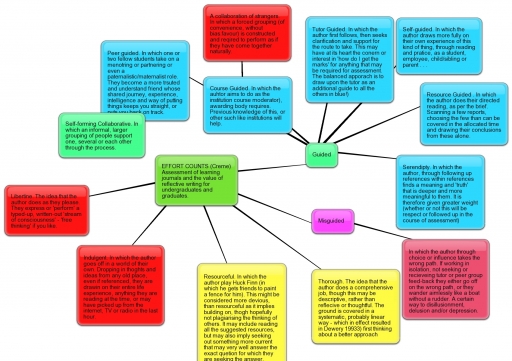Tasked with researching the use of eportfolios in education I can google it, or i can come here. Because I have been there already I come here first.
From JISC I have this:
Why use ePortfolios (JISC)
Engagement across time
The use of e-portfolios to store information relevant to learning helps students track their personal development across time.
A rich picture of learning
The use of e-portfolios can help students to build a rich and detailed picture of their learning. Written coursework can be stored in e-portfolios, but make full use of their digital potential. Videos, photographs and audio recordings can also help students to document a more complete image of their vocational educational experience.
Ask specific questions
Students can be prompted to reflect on their learning by being asked questions. Build this into the e-portfolio. You can ask students to detail: practical activities undertaken; the quality and accuracy of their work; their methods and formative tasks; their reflections on the learning process.
Making feedback accessible
Storing feedback in one place allows students to reflect when they are ready to do so. For one thing, digital feedback is more difficult to lose than paper feed.
Track students’ development
E-portfolios allow teachers to track their students’ learning across time. Teachers are able to see how students are improving and identify students that require more help.
Enhance department assessment
Teachers can provide evidence that their feedback was rigorous and helpful.
Demonstrating achievement
Storing evidence of work in one place enables students to demonstrate their achievements to others. In particular, students finish the course with a single document detailing their educational journey and accomplishments to show to potential employers.
Use familiar programmes
E-portfolios need to be accessible to students and teachers. Using software that students and teachers already feel comfortable with will help create a smooth transition and increase engagement.
Inclusive teaching
Dyslexic students are able to record their work in dyslexic-friendly formats.
Finding the right ePortfolio
Some Options
Below is a list of tools that can be used to collect, organize and share student work. Those that are free are marked with an asterisk (*).
Project Foundry
This tool organizes, tracks and shares learning in a project-based learning classroom. It includes standards-based grading tools and feedback tools. Teachers have the option to include a digital portfolio website for students.
Google Sites*
Create a website to share classwork and projects. Potential users must be at least 13 to sign up. Students can use the “file locker” option to upload files.
Wikispaces and PBwiki* [No longer exists]
These two wiki-creation tools allow students to create a website of their work. Due to the collaborative nature of the tools, student teams can build a workspace to showcase their work. The teacher can create student accounts without an email address. (Note: PBwiki is also known as PBworks.)
Dropbox
Students can create a public folder in Dropbox to share their work. This platform supports multiple file types and can be used collaboratively by sharing folders.
Evernote
Students can create “notebook” within their Evernote account for each class, and that notebook can be shared publicly. Students can upload files to their notebooks, including documents, photos and audio files.
eBackpack
Teachers can assign, collect, grade and return assignments to students through eBackpack. Students can upload files to their digital locker to create an online portfolio for their course. Work uploaded cannot be seen outside of the closed system.
From 'Digital Arts': 15 best portfolio websites for designers and artists
All of these and my direct experience is with:
Wordpress
Pebblepad
